
Keke Kaikhosroshvili
Keke is Zavvy's expert in learning experience. On our blog, she shares experience and insights based on her studies in learning design and experiences made with our customers.

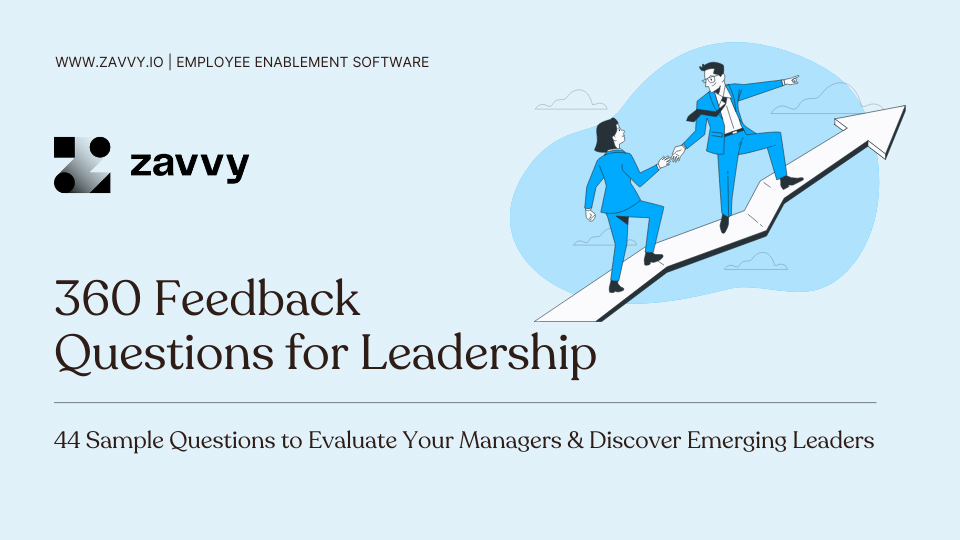
Want to reap the benefits of feedback beyond performance reviews? 360 feedback is a powerful tool to help you identify leadership potential in your organization.
But how do you pinpoint tomorrow's leaders among your employees?
360 degree employee feedback lifts the pressure from you. It builds upon the observations from those who know your future leaders better than anyone – their colleagues.
Use 360 feedback questions for leadership to get a holistic view of your workers' leadership strengths, development opportunities, and needs.
With a 360 degree approach to feedback, managers, direct reports, team leaders, and executives assess one another to paint a more fair and holistic picture of a person's competencies. Thus, you ensure that employees across seniority levels and hierarchies share their insights.
You'll learn two key things in this article:
Together with our curators, we have created a library of actionable digital marketing resources. Personalized to your team's needs.
You can use 360-degree employee feedback for leadership assessment as a means to find potential leaders in your workforce.
In general, the 360 degree philosophy consists of performance assessment by collecting answers bottom-up, top-down, plus peer and self-evaluations.
You invite both upper management and employees to fill in feedback questionnaires. Potentially, clients can also participate.
The feedback can target overall qualities and competencies, like communication or accountability.
For leadership assessment, in particular, you would tailor the questions to spot potential leaders.
When introducing 360 feedback, focus on the benefits:
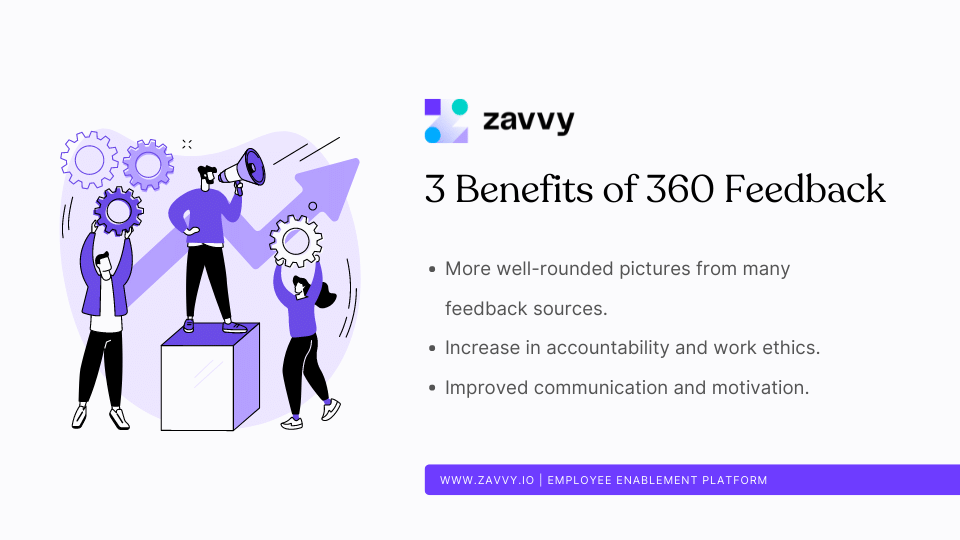
A 360 degree leadership assessment can be part of a leadership competency model. It helps assess leadership potential, identify training needs, and implement relevant leadership development programs.
➡️ To use this template for leaders, make sure that your core leadership competencies go into the "Focus Areas" (First column).
Some areas that you can cover in your 360 leadership assessment template:
As a rule of thumb, 360 feedback questions for leadership should:
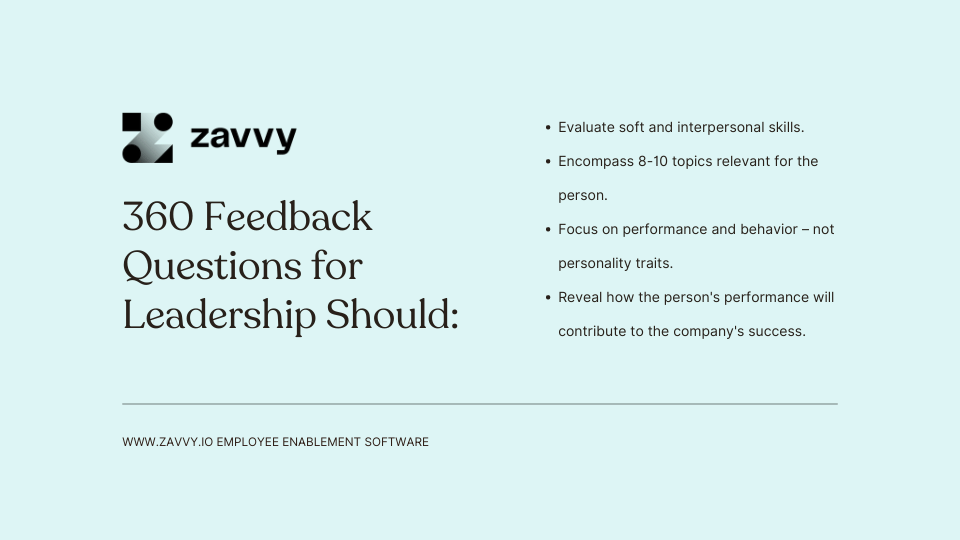
Tip #1: Ensure that you collect insights from multiple sources. Gaining a more holistic picture will avoid a biased view.
Tip #2: Ensure anonymity. Otherwise, people may shy away from giving honest feedback.
You can use these 360 degree questions for managers at all levels – from team leaders to upper management.
Below are some examples of 360 feedback questions for managers. We start with some yes/no questions.
Note: You can switch yes/no questions into statements with a sliding scale.
For example: "The manager is a good representative of company values" followed by options ranging from "Completely Agree" to "Don't agree at all."
These can be added to the 360 degree feedback questionnaire for executives to get a complete picture of the employee's profile.
The view on open-ended questions in a 360 review differs. They can add nuance and motivate choices but require more effort to craft during data processing.
The benefit of using closed-ended questions is that it's easy to score your candidates against each other and see who got the most positive responses. It also saves time from processing and extracting value from their open-ended counterparts.
Plus, it's hard to avoid subjectivity when interpreting open-ended questions. It's ultimately up to you and the resources you have.
Some open-ended questions for managers:
To get an accurate 360 picture, managers themselves have to do a self-evaluation.
The self-evaluation can show where their self-image differs from how others perceive them – and thus map growth opportunities.
Examples of questions for self-evaluation:
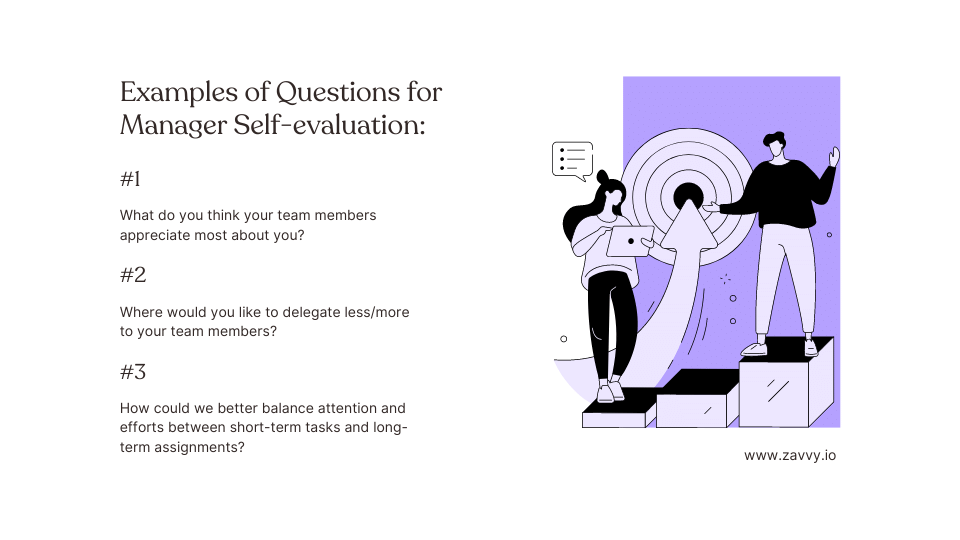
Sometimes we don't see the forest for the trees.
Instead of automatically scouting for new stars outside your company, consider promoting promising candidates among your employees to save time and money.
When you carry out your periodic performance reviews, assess your employees' leadership skills. You might find some untapped talent, which you can grow with a strategic development plan.
Tip #1: Create a career progression framework to show these employees how they can grow within your organization. They will see what competencies they need to acquire or enhance.
A 360 format offers the perfect opportunity to discover emerging leaders: everyone working close to the person can voice an opinion.
The first step in selecting questions for a 360 degree feedback survey to uncover emerging leaders is to decide which leadership qualities are essential to you.
For example: Suppose you're facing a challenge with managers and leaders not responding quickly. In that case, one question should be about how fast the person replies to messages.
Remember: As part of a 360 framework, self-review and self-reflection are essential.
Tip #2: Use the below questions to take the pulse on your people's leadership potential.
Note: These questions can be reframed into statements where the respondent can rate to what extent they agree.
If you want to add some open-ended alternatives to assess new leaders, here are our sample questions:
To get a realistic picture, it's vital that people feel comfortable with being open and honest. Even behind anonymity, some people may be hesitant not to hurt others.
Imagine having engaged employees that look forward to giving and receiving feedback instead of dreading it like the dentist! It is thus essential to creating an atmosphere where feedback is a natural and regular part of the work culture.
➡️ But how do you create a feedback culture at your workplace? Check out our Ultimate guide to creating a feedback culture. We included practical tips and some real-life examples to inspire you.
The reviews by each employee are just the first step – see them as getting the key. For transformation to happen, you need to use the key to open the door.
When inappropriately done, feedback is useless at best. At worst, it can cause negative emotions like resentment and lack of trust.
On the other hand, positive feedback has been linked to positive business outcomes.
Remember: Not all employees respond to feedback in the same way. Some employees desire different approaches.
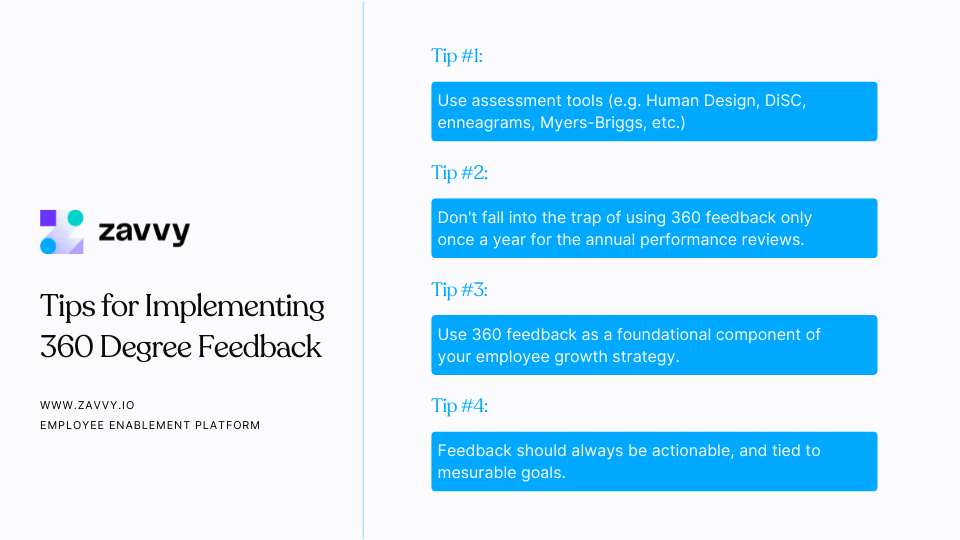
Tip #1: A creative solution is to use assessment tools like Human Design, enneagrams, DiSC, and Myers-Briggs. These tools can support managers with the implementation in a way that resonates with each individual. They can also guide managers in finding and enhancing their leadership styles.
Tip #2: Don't fall into the trap of using 360 feedback only once a year for the annual performance reviews.
Tip #3: Use 360 feedback as a foundational component of your employee growth strategy.
360 feedback will serve as a helpful foundation during performance reviews with managers: It offers an opportunity to reflect on employee evolution and identify areas for further improvement.
Tip #4: Feedback should always be actionable. As such, it can be helpful to elaborate on the results and tie them to measurable goals.
For example: "improving communication skills" is a vague, undefined task, while "replying to emails within twenty-four hours" is something tangible.
Once you have used the 360 degree feedback templates to identify your new managers and leaders, you want to give them appropriate training. But it can be challenging to fit in training with their existing work tasks.
The famous study claiming that humans have a shorter attention span than goldfish is questionable – attention spans online seem to be around 8 minutes rather than 8 seconds.
That said, information overwhelm is real. And that's why microlearning has gained popularity!
Microlearning delivers concise classes on a specific topic. With Zavvy, you can train your new leaders through our micro-coaching program. The teachers are thought-leaders from successful companies like Google, N26, and Deezer.
But won't the slim format impair learning? Research shows the opposite is true. According to the e-learning company EdApp, the average knowledge retention is 70 to 90% with microlearning compared to 15% with traditional learning.
🏢 Discover how Freeletics is building the next generation of leaders with Zavvy using microlessons, leadership onboarding and manager roundtables.
Regular feedback is desired by most people in your team – at least statistically speaking.
A whopping 65% of employees want more feedback. According to the same source, 98% of employees disengage from work if they get little or no feedback.
But giving feedback is not always so straightforward. Often, your employees might perceive it as unfair. This is why you must provide objective, constructive, helpful, and high-quality feedback.
But that is easier said than done.
Moving from linear performance reviews led by the manager to 360 feedback reviews gives a more holistic picture of a person's performance and strengths. So, when rightly implemented, 360 feedback can lead to happier team members that feel recognized.
And you don't need to reinvent the wheel! Use our 360 feedback template to get started, and feel free to elaborate with questions relevant to your company.
And if you're ready to take your feedback processes to the next level, Zavvy is here to help you.
Our 360 feedback solution helps you establish a feedback culture that boosts performance and growth!
Schedule a free 30-minute demo today to see it in action.
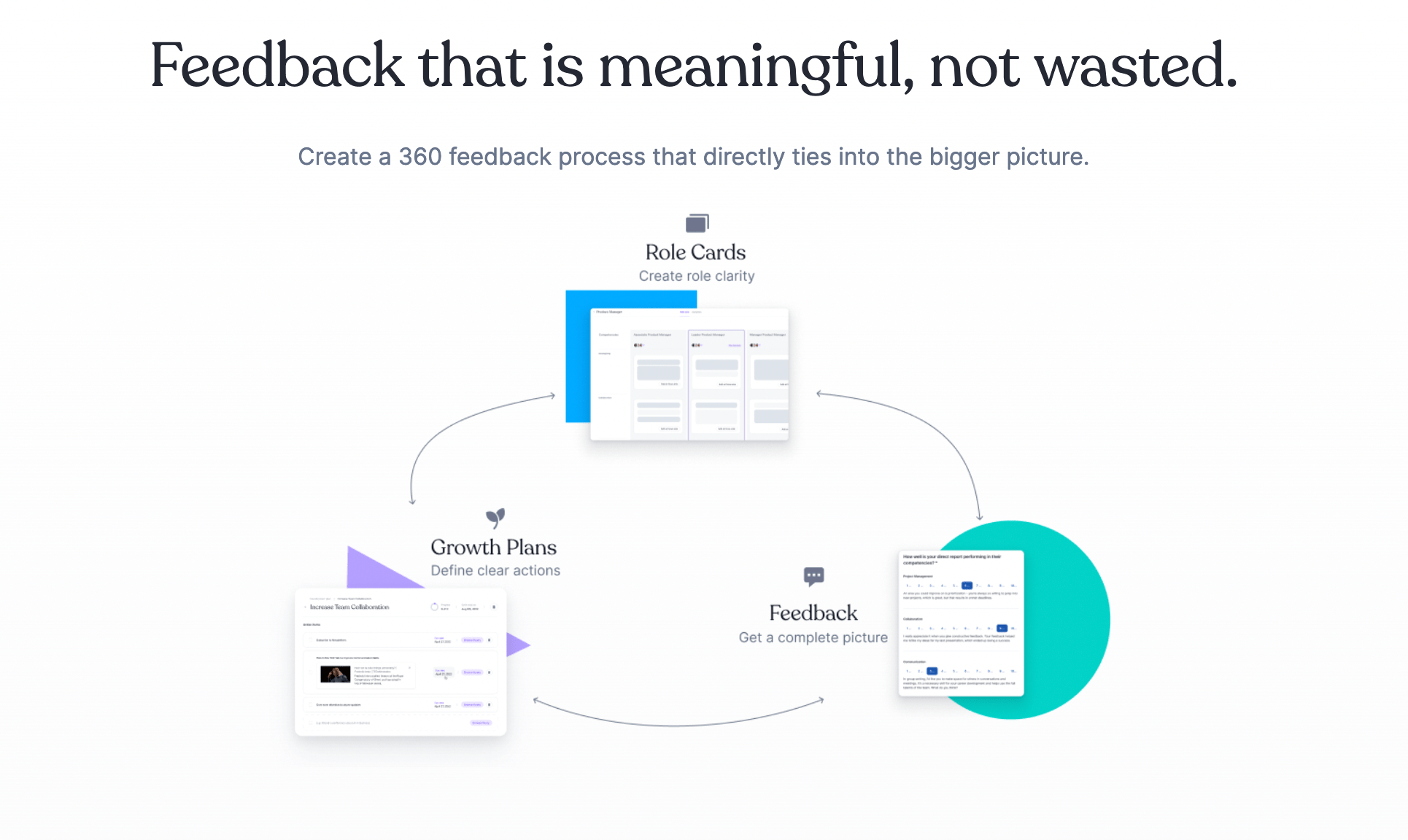
Upskill your team every week with the best contents and personalized recommendations.

Want to reap the benefits of feedback beyond performance reviews? 360 feedback is a powerful tool to help you identify leadership potential in your organization.
But how do you pinpoint tomorrow's leaders among your employees?
360 degree employee feedback lifts the pressure from you. It builds upon the observations from those who know your future leaders better than anyone – their colleagues.
Use 360 feedback questions for leadership to get a holistic view of your workers' leadership strengths, development opportunities, and needs.
With a 360 degree approach to feedback, managers, direct reports, team leaders, and executives assess one another to paint a more fair and holistic picture of a person's competencies. Thus, you ensure that employees across seniority levels and hierarchies share their insights.
You'll learn two key things in this article:
Get a demo!
We'll be happy to show you around and answer all your questions.
Trusted by innovative companies



We'll be happy to show you around, answer your questions, or arrange a free trial.
Erhalten Sie eine kostenlose Demo unserer Onboarding-Software.
Vertraut von



Your Training & Development Strategy - Solved in 1 Tool.
Trusted by innovative companies



We'll be happy to show you around, answer your questions, or arrange a free trial.
Learn how Zavvy helps you drive performance, development, and engagement.
Trusted by innovative companies



We'll be happy to show you around, answer your questions, or arrange a free trial.
We'll be happy to show you around and answer all your questions.
Trusted by innovative companies



We'll be happy to show you around, answer your questions, or arrange a free trial.
Gerne zeigen wir Ihnen ganz unverbindlich unsere Plattform im Detail.
Vertraut von modernen Unternehmen



Get a demo!
We'll be happy to show you around and answer all your questions.
Trusted by innovative companies



We'll be happy to show you around, answer your questions, or arrange a free trial.
Erhalten Sie eine kostenlose Demo unserer Software für Mitarbeiterenwicklung und Training.
Moderne Unternehmen
setzen auf Zavvy


